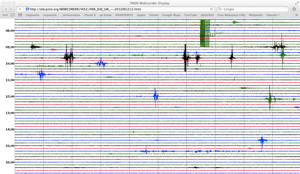SIESMO

OVERVIEW
This is the second in a series of recent works using the transformation of time series data into sound.
The structure of the work uses the Live Internet Seismic Server network (LISS) maintained by US Geologic Survey http://earthquake.usgs.gov/research/software/LISS/index.php . The LISS network provides a feed from a seismograph that can be subscribed based on IP address.
A small computer based open source was adapted to feed near-real time signals to an audio patch. In the first implementation, a list of seismographs are selected, and the live signal is used to manipulate the properties of a synthetic object instantiated for the servo. I did the core development in 2009 .
A sample of the audio component is posted to www.soundcloud.com/philedel mixed to stereo. In a concert setting, the work would be adapted to as many sound channels as available. Currently the piece is implemented in PD but I am interested in porting to MAX as well.
The utility currently runs on 32 windows and LINUX. There’s some software porting work involved to get it to run under MAC OS X x86.
A further refinement will be developed for public presentation. The audio should be accompanied by the listener seeing (probably simple video projection) of the location of the selected seismographs on a map, and optionally, a visualizations of the feeds.
Other area of work in this series was the adaptation of the National Oceanic and Atmostpheric (NOAA) realtime feeds from bouys in NY harbor for the E.A.T. revisited and Cellphonia at Stevens Institue in 2009. There are several other avenues of the NOAA data that seems appealing. A variation on a site specific rendering might inlclude the presentation of the view of that showing a current view of the prime surfing spots around the world. I also would be interested in conjunction with the fractal works finding data source and mappings for tornadoes, tsunami’s, hurricane/typhoons and other weather phenomena. On a recent trip in the summer of 2011, the history of Rhein valley and riparian floods also could be an interesting source. Other time series of interest include earth’s magnetic field, gravitational strength.
There are several other allied efforts that are for future consideration. There is also a guy in audio recordings of lava flows volcano.oregonstate.edu.volcano-sounds worth looking in to. Sunspots and solar activity also is an interesting and attactive source. The National Center for Atmospheric Research (NCAR) in Boulder Colorado has been active in the recent NASA unmanned satellite initiate that supplies near-realtime feeds of solar activity and solar weather. Recent research has identified solar sound waves that propagate across the sun resuting from explosive solar events in and at the surface of the sun.
